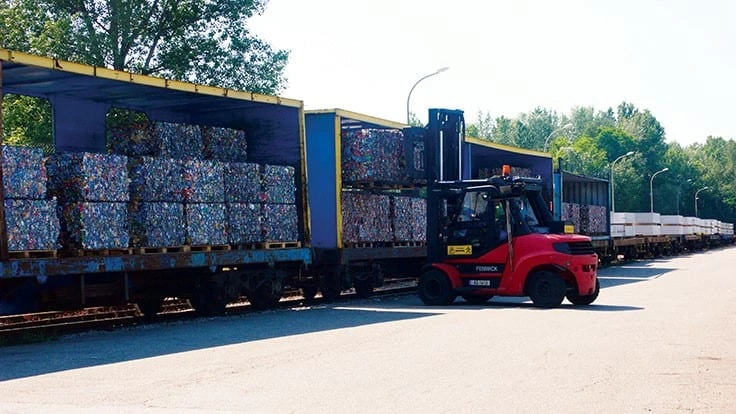
Photo courtesy of Constellium
The Can Manufacturers Institute (CMI) and its members, which include can sheet producers and beverage can makers, have announced ambitious U.S. recycling rate targets that include a 70 percent recycling rate by 2030 and a 90 percent rate by 2050. The used beverage can (UBC) recycling rate was 45 percent in 2020.
CMI, which is headquartered in Washington, has set the targets, outlining its approach for attaining them in four action pillars:
- catalyze the passage and implementation of well-designed deposit systems at the state and federal levels;
- increase and improve household and away-from-home recycling;
- ensure that more cans are properly sorted at recycling centers; and
- increase consumer understanding on the importance of aluminum can recycling and the ability to collect and sell used beverage cans for cash.
CMI says its members are committed to increasing UBCs recycling, noting that nearly 90,000 UBCs are recycled every minute in the United States, with 93 percent going from the recycling bin back to store shelf as a new can in as little as 60 days. This has enabled the aluminum beverage can to have 73 percent average recycled content on average. Increasing the recycled content of the average can reduces its carbon footprint as making an aluminum beverage can from recycled aluminum results in more than 90 percent less greenhouse gas emissions than making the container from primary material.
The CMI adds that high demand for aluminum beverage cans necessitates increasing the UBC recycling rate, which also would enhance the resiliency of the domestic aluminum supply chain.
In its effort to increase the UBC recycling rate, the CMI is touting the inherent value of the material. The association says UBCs are among the most valuable commodities in the recycling stream. While they are only 3 percent by weight of all the recyclables generated by single-family U.S. homes, they represent nearly half of the revenue of those recyclables, the CMI says. It points to a recent study that concluded that most of the material recovery facilities wouldn’t be able to operate with their current business models without the revenue from UBC sales.
Robert Budway, CMI president, speaking during an online press conference Nov. 10 to announce the industry’s recycling goals, said that if the UBC recycling rate had been 70 percent in 2020 rather than 45 percent, 25 billion more cans would have been recycled, generating more than $400 million in revenue and saving enough energy to power more than 1 million homes for a year.
CMI members supporting the targets are aluminum beverage can manufacturers Ardagh Metal Packaging, Canpack, Crown Holdings and Envases, and aluminum can sheet suppliers Constellium, Kaiser Aluminum, Novelis and Tri-Arrows Aluminum.
“CMI’s aluminum beverage can recycling goals are inspired by our member’s commitment to sustainable and responsible world class, circular manufacturing processes,” CMI President Robert Budway says. “The industry is working collaboratively to increase recycling rates to benefit not only the industry’s growth but also to strengthen the U.S. economy and play our part in planet stewardship.”
Under its first pillar of action, the CMI published a joint statement in September with the polyethylene terephthalate, or PET, and glass bottle industries in support of well-designed deposit systems. Further, CMI is advocating for a national deposit system in conversations with lawmakers, however Scott Breen, CMI vice president of sustainability, speaking during the press conference, said that while the industry would “love to see a national deposit system that is efficient and effective” because it would have the quickest and largest impact, the CMI is not “putting all its eggs in one basket.” Therefore, the association is targeting a few states where such legislation likely could pass quickly.
Under the third pillar of proper sorting, the CMI issued its fourth grant in a can capture program, funded by Ardagh and Crown in partnership with The Recycling Partnership, to Milwaukee-area facility. Collectively, these four grants will lead to equipment installed that ensure the proper sortation and recycling of 67 million additional used beverage cans annually, the CMI says.
Also speaking during the press conference, Keefe Harrison, CEO of The Recycling Partnership, Falls Church, Virginia, said, “The aluminum can industry has been committed to recycling for decades. They helped start The Recycling Partnership, and with these goals today, they are leaning in even further. We know that recycling is good for the economy and the environment, specifically carbon savings by making sure that those cans displace virgin material. That is why we are going to work hard with the industry to make these goals a reality.”
The CMI says it will publish a road map in early 2022 that will include more details on how its targets will be achieved through its four pillars.
Also released this week by the CMI and the Aluminum Association, Arlington, Virginia, was an updated "The Aluminum Can Advantage: Sustainability Key Performance Indicators 2021" report, which demonstrates the sustainability advantages of the aluminum beverage can compared with competing packaging types. The report updates several key performance indicators (KPIs) for 2020 and finds that consumers recycle aluminum cans at more than double the rate of PET bottles. Aluminum beverage cans also contain anywhere from 3-times to 20-times more recycled content than glass or PET bottles and generally are more valuable as scrap, making aluminum a key driver of the financial viability of the recycling system in the United States. This year’s report also introduces a brand-new KPI, the closed-loop circularity rate, which measures the percentage of recycled material used to go back into the same product--in this case a new beverage container. A two-page report summary is available here.
Sponsored Content
Still relying on manual sorters?
Let AI do the heavy lifting. Waste Robotics delivers reliable, high-performance robots tailored for complex waste streams. They require minimal maintenance, are easy to operate, and are designed to boost your recovery rates. Smarter sorting starts with the right partner. Waste Expo Booth #1969 & REMA #2843
Click here to see our robots in action!The Aluminum Association also endorsed the CMI effort to increase the UBC recycling rate.
Get curated news on YOUR industry.
Enter your email to receive our newsletters.
Latest from Recycling Today
- USTR announces phased measures designed to address China’s shipbuilding dominance
- APR, RecyClass release partnership progress report
- Clearpoint Recycling, Enviroo sign PET supply contract
- Invista expanding ISCC Plus certification program
- Redwood partnership targets recycling of medium-format batteries
- Enfinite forms Hazardous & Specialty Waste Management Council
- Combined DRS, EPR legislation introduced in Rhode Island
- Eureka Recycling starts up newly upgraded MRF








